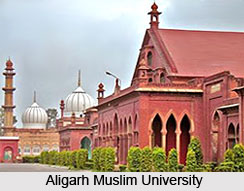 Aligarh is one of the most renowned commercial as well as educational centers of North India. The city produces and exports different types, kinds and sizes of locks. Lock manufacturing and export remains the lifeline of the city. Another famous product that can be bought in Aligarh are Brasses. Aligarh is also famous for its `Aligarh Pajamas`. These dress materials are of fine qualities and have no parallels in India.
Aligarh is one of the most renowned commercial as well as educational centers of North India. The city produces and exports different types, kinds and sizes of locks. Lock manufacturing and export remains the lifeline of the city. Another famous product that can be bought in Aligarh are Brasses. Aligarh is also famous for its `Aligarh Pajamas`. These dress materials are of fine qualities and have no parallels in India.
Aligarh remained as a center for various movements that have re-shaped India.
Aligarh is synonymous with the famous Aligarh Muslim University. The college was established by Sir Syed Ahmed Khan in order to help Muslims to come in terms with the changing realities of the world. In the later years, the city also became the launch pad for the nationalist movements in India including the famous Khilafat Movement. The city has been home to various nationalist leaders as Syed Brothers, Maulana Abul Kalam Azad, Maulana Sibli Nomani and Zakir Hussein among others.
Geography of Aligarh
Aligarh is a city located in Uttar Pradesh state of Northern India. The city is about 90 miles east to New Delhi, situated on a plain between the Ganges and Yamuna. The city is the administrative district of Aligarh District. Aligarh is located at 27.88° N 78.08° E. the average elevation of the city is 178 meters. The summer temperature varies between 43°C to 30°C and winter temperatures between 25° C to 5° C.
Transport of Aligarh
Aligarh is well connected to rest of the country by means of air, rail and road.
By Air - the nearest airport is New Delhi, which is 130 kilometers from downtown Aligarh.
By Rail - The main railway station in Aligarh is Aligarh Junction. Aligarh is well connected to cities of New Delhi, Agra, Kanpur, Lucknow, Benaras, Jaipur, Kolkata and Mumbai through a cluster of super fast and express trains.
By Road- Aligarh is well connected to other cities through a network of National and State Highways. The city has regular buses to destinations like Jaipur, Agra, Mathura, Ghaziabad, New Delhi, Lucknow and Varanasi.
Education of Aligarh
 One of the best universities of the whole Asia is the Aligarh Muslim University located at the heart of Aligarh. It is an institution of international repute offering more than 250 courses in traditional and modern branches of education. Aligarh Muslim University is the second largest Muslim University in the world after the world famous and renowned Al Azhar University in Cairo. Students from Africa, West Asia and South East Asia are drawn towards this University.
One of the best universities of the whole Asia is the Aligarh Muslim University located at the heart of Aligarh. It is an institution of international repute offering more than 250 courses in traditional and modern branches of education. Aligarh Muslim University is the second largest Muslim University in the world after the world famous and renowned Al Azhar University in Cairo. Students from Africa, West Asia and South East Asia are drawn towards this University.
The other schools of Aligarh are Our Lady of Fatima Higher Secondary School, Delhi Public School, St. Fidelis, Aligarh Public School, Three Dots, D.S. Degree college, S.V. Degree college ,T.R. Girls college, Institute Of Information Management and Technology (IIMT) and Blue Bird Senior Secondary School.
Economy of Aligarh
The city is one of the major business centers of Uttar Pradesh. The city of Aligarh is famous for locks and sculptures. The locks produced in Aligarh city are exported all over the world and is of great demand everywhere. The city is as well as a major center for Brass Hardware and sculptures.
Demographics of Aligarh
As per the 2001 census, the population of Aligarh is 667,732. Males constitute 53% of the population and females 47%. Aligarh has an average literacy rate of 55%, which is lower than the national average of 59.5%. The male literacy rate is larger than the female literacy rate. 59% of the males are literate and 41% of the females are literate in Aligarh.
Places of Interest in Aligarh
The two important places of interest in Aligarh are :
•Aligarh Fort
•Aligarh Muslim University`s campus.
The city also has well known markets as Railway Road market, Centre Point Market, Amir Nisha and Shamshad market. The center point market is popular for its savoury cuisines. The Amir Nisha market is a major shopping hub famous for its variety of clothes, jewelery and cosmetics. The Shamshad market is a popular book shop.



















